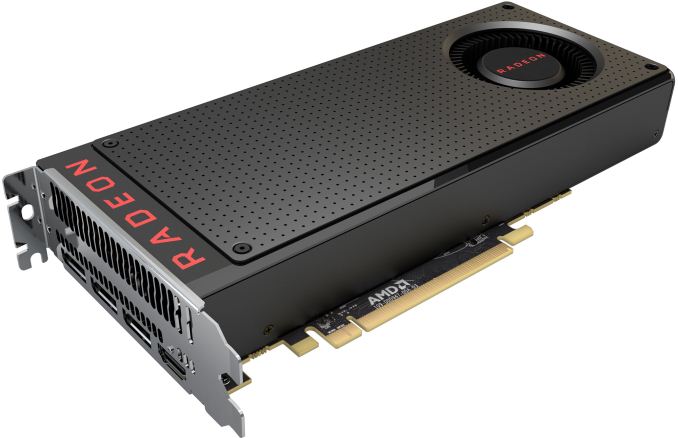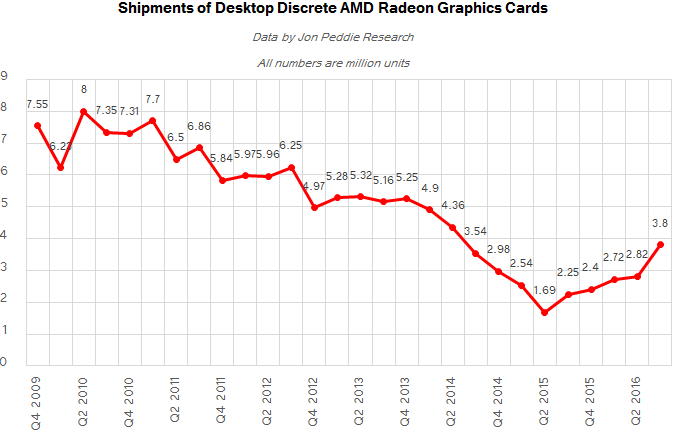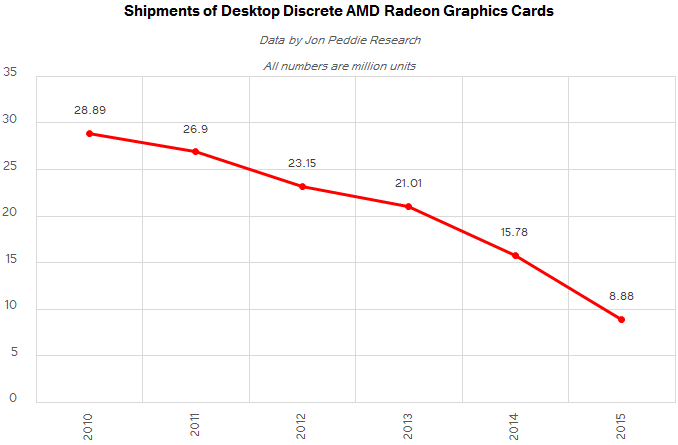Discrete Desktop GPU Market Trends Q3 2016: GPU Shipments Hit Two-Year High
by Anton Shilov on November 28, 2016 9:00 AM ESTAMD: Polaris Now Accounts for 50% of Channel GPU Revenue
Shipments of AMD’s GPUs (both standalone and integrated) were strong in Q3 2016: sales of desktop GPUs were up 34.7% QoQ, shipments of mobile GPUs were up 23% sequentially, supplies of desktop APUs decreased by 10% from the previous quarter and sales of mobile APUs grew by 19.1% QoQ, according to Jon Peddie Research. Overall, AMD’s PC graphics shipments increase by 15.4% from the previous quarter, JPR reports.
AMD does not disclose a lot of information about its GPU shipments. However, in its recent conference call the company confirmed that its quarterly channel GPU revenue and ASP in Q3 hit record levels since early 2014 and that the Radeon RX accounted for more than 50% of its channel GPU revenue. Furthermore, AMD said that its professional GPU revenue increased for the fourth consecutive quarter.
“The launch of our expanded family of Polaris desktop GPUs and our first full quarter of RX 480 sales drove our highest quarterly channel GPU revenue and ASP since early 2014,” said Lisa Su, CEO of AMD, during the conference call with investors and financial analysts. “The Radeon RX GPUs now account for more than 50% of our channel GPU revenue.”
AMD admitted that early in Q3 it could not meet demand for its new products made using 14 nm FinFET (14LPP) process technology, but things got better later in the quarter. As PC makers roll out new systems featuring AMD’s Polaris and other chips in Q4, the company hopes to either maintain or even increase its GPU shipments this quarter.
“We are very happy with how Polaris ramped in Q3,” said Dr. Su. “The customer demand across all geographies was very strong. Q3 was primarily a channel-based quarter. […] In the early part of Q3, we actually had some supply constraints, given the customer demand, [but] we did catch up towards the end of the quarter. […] As we go into Q4, in addition to the channel partners continuing to ramp, you should expect some OEMs launching in Q4 more broadly.”
AMD’s sales of desktop discrete GPUs in total for 2016 (Q1 to Q3) have already hit 9.34 million units, which is more than 8.8 million desktop graphics processors the company shipped in 2015. It is unknown whether AMD manages to increase its desktop GPU sales in Q4 substantially over Q3 to actually beat its 2014 results (15.78 million), but it is clear that AMD’s desktop GPU business is performing better this year than it did in 2015.
From the market share point of view, it remains to be seen how well AMD will respond to challenges imposed by NVIDIA’s Pascal GPUs in the performance market segment (i.e., $100-$249). In Q3 the company had to compete against NVIDIA’s Pascal-based GeForce GTX 1070/1080 graphics cards using its products released in 2015 (Fiji) and 2013 (Hawaii). None of those chips are manufactured or supplied today, which is why we see that prices of the Radeon R9 Fury- and the Radeon R9 390-series graphics cards vary greatly (e.g., you can get a Fury X for $299.99 after $30 rebate, or you can get the same card for $799.95). Some of AMD’s partners attempt to get rid of older products, others believe that since there will be no more Fiji or Hawaii chips, they will be able to capitalize on short supply of AMD’s high-end GPUs in the fourth quarter. In the meantime, AMD itself is gearing up to launch its Greenland/Vega high-end GPU in 2017 and has no plans to ship more Fiji or Hawaii processors (at least in mass quantities for consumer graphics adapters).













53 Comments
View All Comments
RussianSensation - Friday, December 2, 2016 - link
I5 2500K/2600K turn 7 years old next month, since they were released on January 2011!catavalon21 - Sunday, December 11, 2016 - link
How about splitting the difference, and call it 6 years old?Araa - Monday, November 28, 2016 - link
Never been an AMD fan myself but I hope they get out of the slumber they are currently in. I want the good ol' 2010 days back where they were a strong second.Keao - Monday, November 28, 2016 - link
Yeah and back then GPU mid-tier was a bargain :-)Aaaah I miss the days of the RADEON HD4870...
Stuka87 - Monday, November 28, 2016 - link
In 2010 AMD was in first place. Thats back when the 5000 series was king of the hill and the GTX 400 series was delayed 6 months and shipped as a power guzzling pig. It was later on when the updated 500 series brought nVidia back in front as the AMD 6000 series was just a basic re-badge.silverblue - Tuesday, November 29, 2016 - link
Not quite; the 6900 series moved from VLIW5 to VLIW4 due to AMD realising that the average slot utilisation was 3.4, hence there were efficiency gains to be made in reducing the size of each shader block. The 6870 and below were based off the 5000 series, however.just4U - Friday, December 2, 2016 - link
While the 470/80 were guzzlers for sure .. the 460 was the little darling... priced well and gave Nvidia fans something to cheer about. The 500 series certainly brought more to the table, however AMD was matching them in performance while beating them on pricing...I always remember wanting a 560Ti or a 570 but could never justify it on the price so opted for the AMD equivalent... sad to because even as it was about to be discontinued the damn cards never did come down in price. That's when I started to get a little miffed with Nvidia. After the TNT2 They really began to sock it to you price wise with the Geforce line... That's something ATi never really did... even when they were the king of graphics in the early 90s.
Strunf - Thursday, December 8, 2016 - link
ATI/AMD, nVIDIA will charge as much as they can... there are no good guys, they are quoted on the stock market and hence profit driven.In the early 90s the graphics card wasn't so important and there were a few players ATI, S3, Matrox, Intel... then the 3D accelerators kicked in and the market went crazy.
Samus - Tuesday, November 29, 2016 - link
I haven't had an AMD GPU since AMD bought ATI that I liked. They were cheaper, for the same performance as nVidia, but they failed early, the drivers were awful, and their partners were and still are lousy. AMD doesn't have an equivalent OEM builder to nVidia such as PNY or EVGA.And before you laugh about PNY, remember that PNY is actually the largest distributor of nVidia cards. By quite a lot. I remember reading a few years ago that PNY shipped more cards than every other nVidia partner COMBINED. All those Quadro's have helped their bottom line as well.
peterfares - Wednesday, November 30, 2016 - link
ASUS makes AMD cards. They're reputable.